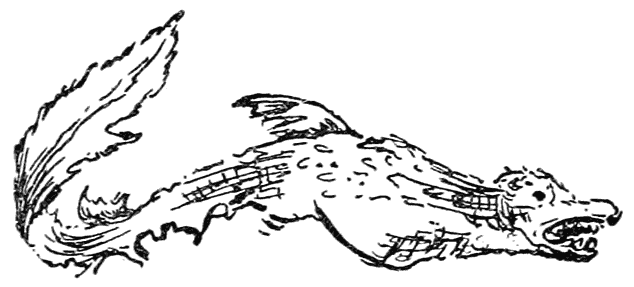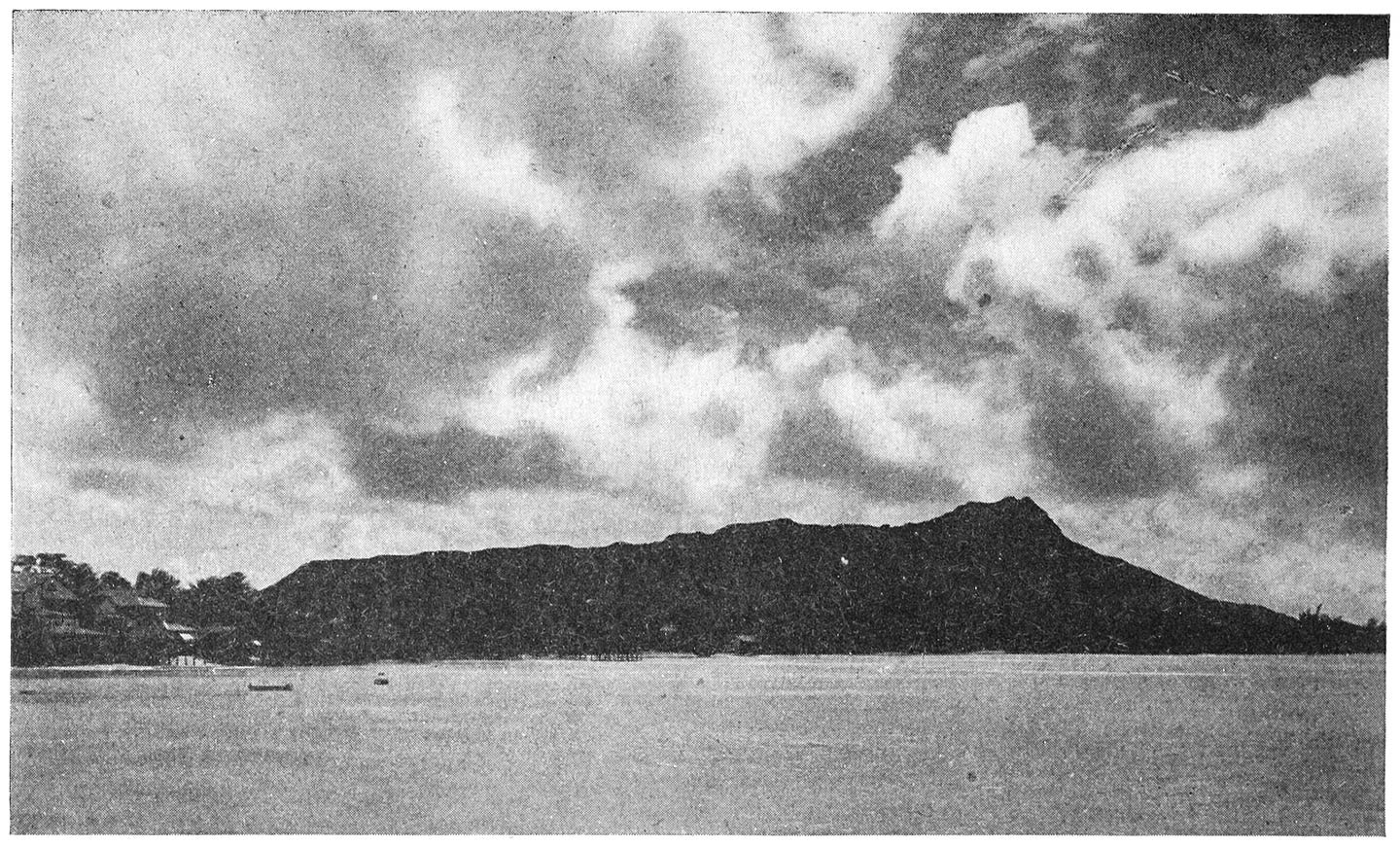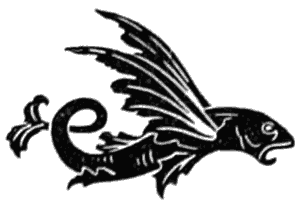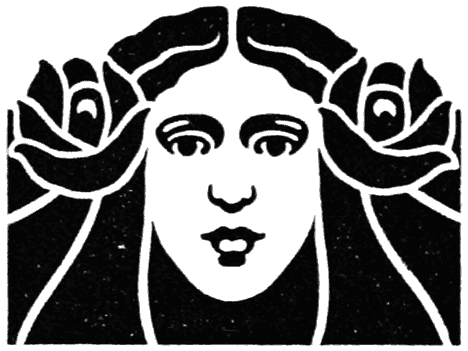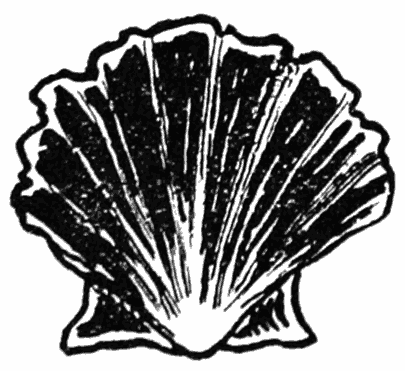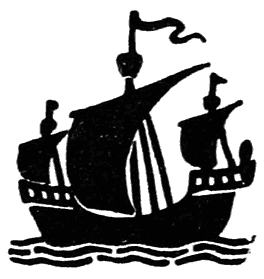
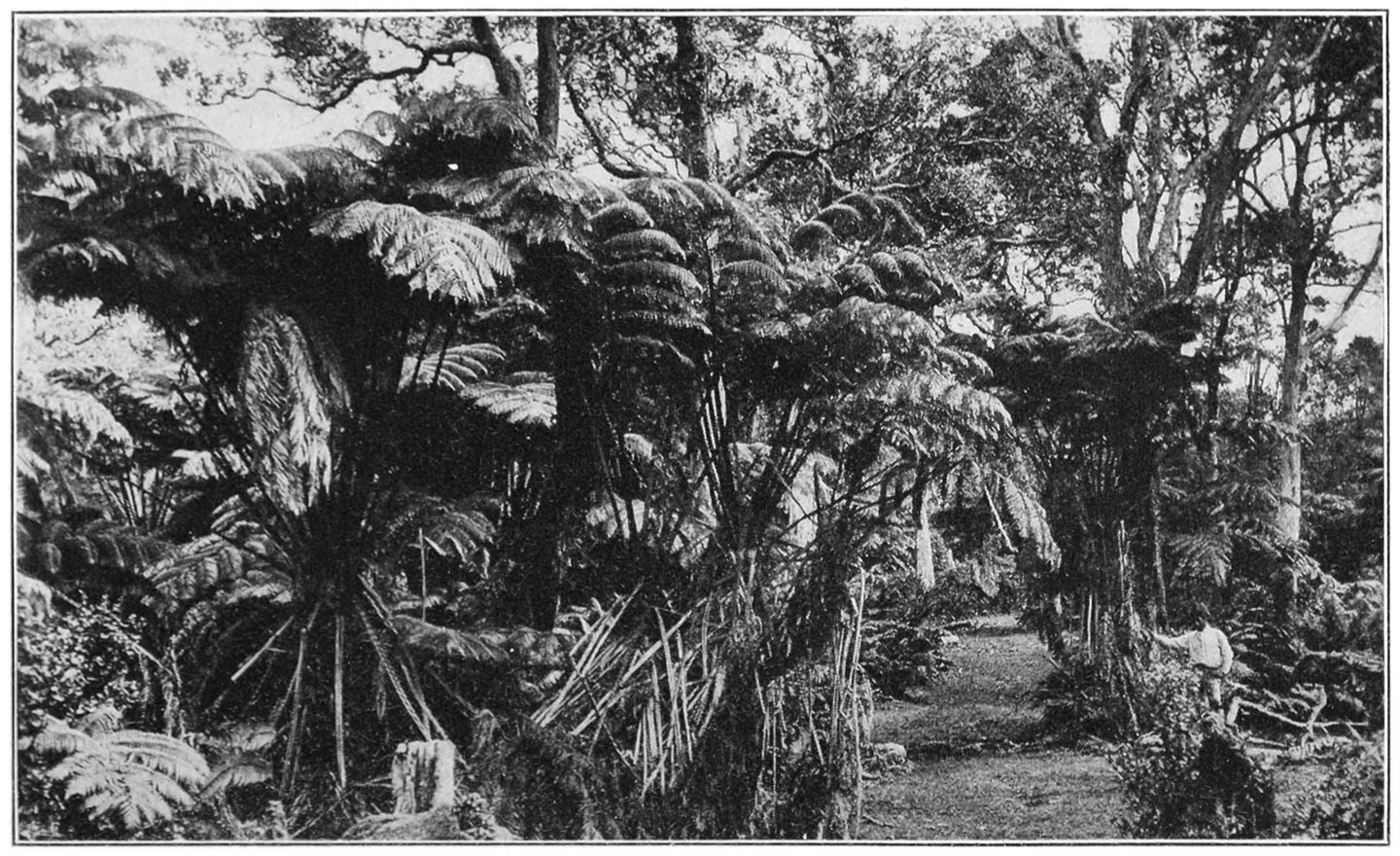
GIANT TREE FERNS ON THE ROAD TO KILAUEA

of
VOLCANOES
CONSTABLE & CO., LONDON, G.B.
1916
Copyright, 1916, by William Drake Westervelt Honolulu, T.H.
BOSTON, U.S.A.
PRESS OF GEO. H. ELLIS CO.
LONDON
CONSTABLE & CO., LTD.
10 Orange St., Leicester Sq., W.C.
1916
[iii]
FOREWORD
However doctors may differ concerning the way that our earth came into being, most of them agree that in its early days meteoric bodies from space flew together and produced a hotter globe than at present. Perhaps its surface was all covered with vast circular lakes of lava such as our telescopes reveal in great perfection, ring upon ring, over the surface of the moon. On the moon these rings and pits are now cold, remnant from a time when the gases from the inside of our satellite were bubbling forth from a great internal heat supply and bringing with them oceans of slag which seethed and swirled in circular pools which formed symmetrically within ramparts of their own spatter.
The earth is not without traces of similar circular ramparts in the shape of long curved chains of volcanoes, mostly in the sea, which would appear as ridges if the ocean were to dry up. The line of the Hawaiian Islands from Kauai to Mauna Loa on the large island of Hawaii is such a curved ridge, now of enormous height [iv]above the bottom of the Pacific, but perhaps at one time much lower and more extended into something like a circle. These islands appear to have been built by overflows of lava from a curved crack which followed along the old rampart, just as we now find smoke-cracks along the small ramparts which restrain the hot lavas in Halemaumau in the pit of Kilauea. The last activity along this crack appears to have moved slowly through thousands of years from west to east, and each volcanic mountain that was built made a stopper to force the liquid out along the crack farther eastward until finally two live volcanoes, Mauna Loa and Kilauea, were left at the extreme east end, still spouting out the liquid and building up domes.
Some men of science say that the molten liquid, which is mostly an iron-stained glass, foamy with the intensely hot gases which escape from the inside of the earth, comes from an under layer beneath the outer crust of the earth, which would be found anywhere if we went down deep enough. Others say that it comes from scattered pockets of liquid under a stiff shell and over a stiffer inner globe. However this may be, there is some agreement that the depth from which the liquids come is about seventy miles and we know that vast quantities of gas escape with them. Possibly the gases [v]unite chemically with each other and so themselves produce some of the heat.
It is clear that heat and gas action are the motive agents which make volcanoes so lively, so much so that simultaneously Mauna Loa and Kilauea may maintain liquid columns of lava at two different elevations ten thousand feet apart. This is accounted for by the fact that the melted glass is so charged with gases under high pressure that it seethes up and down in the cracks and tubes which it occupies according to their form and size, and according to the coming together or opening apart of their walls, just as any sparkling wine makes a foam which rises or falls according to the suddenness of the uncorking or to the size of the glass into which it is poured.
Sudden uncorking is an apt simile for volcanoes in general, as most of them, unlike Kilauea, erupt very suddenly and explosively. This is due to the way in which the gas-charged liquid has become confined under the solidified mountain, and so only at long intervals becomes so hot and so insinuating that it finds a way out and, once released, spouts like the open safety-valve of a steam engine until the gas pressure is relieved. But even Kilauea is not guiltless of terrific and destructive explosive eruption. About 1790, thousands of tons of gravel and [vi]boulders and dust were strewn over Hawaii from Kilauea, covering hundreds of square miles, destroying the vegetation, and killing some of the people. This would appear to be a crisis reached every few centuries, and perhaps dependent on a building up of the mountain by lava to a certain height where the foam column is so confined that it can no longer overflow and so is compelled to explode.
Mauna Loa is a much more productive volcano than Kilauea, for its flows have covered a vast territory with new lava within the century past, whereas Kilauea has done much less overflowing. Everything indicates that Kilauea is older than Mauna Loa. Mauna Loa with its flows is tending through the ages to bury up Kilauea, and it is quite possible that within a few centuries there will be flows from Mauna Loa which will cascade over the wall into Kilauea crater and so make Kilauea Mountain appear to be a mere spur of Mauna Loa. Mauna Kea to the north appears to have been a great circular volcano about one hundred miles in diameter, and when it had extinguished itself by too much building, its lava took refuge in making two new cones out on the edge of the old mountain, namely Kilauea and Hualalai. These built up until they had nearly exhausted the lava available, owing to their height, and then a new vent, [vii]Mauna Loa, burst out in the center, filling a long spoon-shaped valley between them and to the southwest of Mauna Kea. The new mountain has now built itself up to a height almost equal to that of Mauna Kea and probably in a few centuries will begin exploding and heaping up cinder cones just as Mauna Kea did before it finally became extinct.
Some such story as this outlines the tremendous events, explosions, whirlwinds, avalanches, lava flows, earthquakes, and fiery blasts which composed the narrative of the domain of Pele before man appeared upon the scene. We do not know how much more frequent these things were in the old days, but there were probably eras of quiet and eras of excitement just as at present. It behooves us to give the closest possible attention to all the events of the present and to record them faithfully, so as to render to the scientific historian of the future a consecutive account of all the details which will lead up to some great crisis in the days to come.
T. A. Jaggar, Jr.,
Director Mass. Inst. Technology,
Hawaiian Volcano Observatory,
Kilauea Crater, October, 1916.
[viii]
PRONUNCIATION
“A syllable in Hawaiian may consist of a single vowel, or a consonant united with a vowel or at most of a consonant and two vowels, never of more than one consonant. The accent of five-sixths of the words is on the penult, and a few proper names accent the first syllable.
In Hawaiian every syllable ends in a vowel and no syllable can have more than three letters, generally not more than two and a large number of syllables consist of single letters—vowels. Hence the vowel sounds greatly predominate over the consonant. The language may therefore appear monotonous to one unacquainted with its force.
In Hawaiian there is a great lack of generic terms, as is the case with all uncultivated languages. No people have use for generic terms until they begin to reason and the language shows that they were better warriors and poets than philosophers and statesmen. Their language, however, richly abounds in specific names and epithets.
The general rule, then, is that the accent falls on the penult; but there are many exceptions and some words which look the same to the eye take on entirely different meanings by different tones, accents, or inflections.
The study of these kaaos or legends would demonstrate that the Hawaiians possessed a language not only adapted to their former necessities but capable of being used in introducing the arts of civilized society and especially of pure morals, of law, and the religion of the Bible.”
The above quotations are from Lorrin Andrew’s Dictionary of the Hawaiian Language, containing some 15,500 Hawaiian words, printed in Honolulu in 1865.
| Hawaiian vowels | a is sounded as in father | |
| e is,, sounded,, as,, in,, they | ||
| i is,, sounded,, as,, in,, marine | ||
| o is,, sounded,, as,, in,, note | ||
| u is,, sounded,, as,, in,, rule or as oo in moon | ||
| ai when sounded as a diphthong resembles English ay | ||
| au when sounded as a diphthong resembles ou as in loud |
The consonants are h, k, l, m, n, p, and w. No distinction is made between k and t or l and r, and w sounds like v between the penult and final syllable of a word. [ix]
TABLE OF CONTENTS
| CHAPTER | PAGE | |||||||
| Foreword | iii | |||||||
| Introduction | xi | |||||||
| PART I—LEGENDS | ||||||||
| I. | Ai-laau, The Forest Eater | 1 | ||||||
| II. | How Pele came to Hawaii | 4 | ||||||
| III. | Pele and the Owl Ghost-god | 14 | ||||||
| IV. | The Hills of Pele | 19 | ||||||
| V. | Pele and the Chiefs of Puna | 27 | ||||||
| VI. | Pele’s Tree | 35 | ||||||
| VII. | Pele and Kaha-wali | 37 | ||||||
| VIII. | Pele and Kama-puaa | 45 | ||||||
| IX. | Pele and the Snow-goddess | 55 | ||||||
| X. | Genealogy of the Pele Family | 63 | ||||||
| XI. | Pele’s Long Sleep | 72 | ||||||
| XII. | Hopoe, the Dancing Stone | 87 | ||||||
| XIII. | Hiiaka’s Battle with Demons | 96 | ||||||
| XIV. | How Hiiaka found Wahine-omao | 104 | ||||||
| XV. | Hiiaka Catching a Ghost | 111 | ||||||
| XVI. | Hiiaka and the Seacoast Kupuas | 117 | ||||||
| XVII. | Lohiau | 126 | ||||||
| XVIII. | The Annihilation of Keoua’s Army | 139 | ||||||
| XIX. | The Destruction of Kamehameha’s Fish Ponds | 146 | ||||||
| XX. | Kapiolani and Pele | 152 | ||||||
| PART II—GEOLOGICAL FACTS | ||||||||
| I. | The Crack in the Floor of the Pacific | 165 | ||||||
| II. | Hawaiian Volcanoes | 170 | ||||||
| III. | Volcanic Activity | 177 | ||||||
| IV. | Changes in Kilauea Crater | 189 | ||||||
| V. | Foundation of the Observatory | 194 | ||||||
[x]
LIST OF ILLUSTRATIONS
| Giant Tree Ferns on the Road to Kilauea | Frontispiece | |||||||
| PAGE | ||||||||
| Fire Fountains in Halemaumau, Kilauea | 2 | |||||||
| Lava Cave | 16 | |||||||
| Decked with Leis of Plumeria | 24 | |||||||
| Hibiscus | 39 | |||||||
| Mokuaweoweo, Mauna Loa (in eruption 1899) | 44 | |||||||
| Asa-Yama, Japan | 52 | |||||||
| Ice-crested Chimborazo (Ecuador, S.A.) | 60 | |||||||
| Mt. Shasta, California | 70 | |||||||
| Mt. Rainier, Washington | 78 | |||||||
| Mt. Shishaldin, Alaska | 88 | |||||||
| Mt. Katmai, Alaska | 98 | |||||||
| Sunset over Leahi | 108 | |||||||
| A Storm on Mount Haleakala | 118 | |||||||
| Lohiau | 128 | |||||||
| Two Maori Girls in Ancient Greeting | 140 | |||||||
| Twisted Lava at the Foot of Vesuvius | 150 | |||||||
| Smoke Column over Mt. Pelée | 160 | |||||||
| Kaimimiki | 178 | |||||||
| Hawaiian Volcano Observatory | 194 | |||||||
| Map of Hawaii | 204 | |||||||
Note:—The great volcanoes of the Hawaiian Islands on account of their magnitude, gradual slope, character and location do not lend themselves to interesting photography, as whatever is attempted must be done at sea on swaying ships in rough channels some distance out and detail is lost, hence the illustrations in this volume include many of the vast craters forming the volcanic rim which surrounds that “Crack in the Floor of the Pacific” over which the Hawaiian Islands are situated. [xi]
INTRODUCTION
THE HAWAIIAN ISLANDS
Of all the noteworthy groups of islands of fire rock in the Pacific Ocean, the Hawaiian Islands are the most stupendous.
The crack in the floor of the ocean upon which they are built extends from the large island Hawaii northwesterly about two thousand miles toward Japan. The islands for the first four hundred miles are large and mountainous, but as the chain is followed toward the end, the islands quickly become mere bluffs rising out of the sea, or low coral islands which have been built on the rims of submerged volcanoes.
It is interesting to note that the oldest, the smallest, and the lowest of these islands lie nearest to Japan. One of these—Midway Island—is used as the United States mid-Pacific cable station. Properly speaking, the Hawaiian Island group should cover all the islands in this chain two thousand miles long. The mountains of the large islands rise from 3,000 to 14,000 feet above the sea-level. Between this majestic [xii]range of island mountains and the “Giants of the Rockies,” along the western coast of the United States, lies a rough ocean valley abounding in hills and deep ravines with an average depth under the sea-surface of about 2,600 fathoms, or 15,600 feet.
We know very little about this valley save that its floor is covered with evidences of volcanic action. Pumice and scoriæ appear to be universally distributed on the bottom of the ocean. Red and gray, and blue and green clays abound. The disintegration of pumice is given as the chief source for the formation of this clayey matter. Sometimes the deposits are permeated with meteoric or star dust.
As the ocean depths draw near the island coasts, they grow more and more shallow and become a wonderful fairy-land into which the dreamer looks from his floating canoe. Strange branching thickets of coral lie below, sometimes fringed with moving seaweeds and exquisitely colored sea-mosses, while through the coral and moss swim the marvellously painted fish of a hundred varieties. Turning and twisting in and out of coral caves are the spotted eels or the great pink or brown anemone-headed sea-worms. Sea-urchins and star-fish crawl lazily along the valleys and the uplands of the coral reef. The surface of the sea is itself [xiii]covered with ceaselessly moving waves reflecting a tropical luxuriance of color. From well-known localities hundreds of fishermen gather spoil for the sustenance of life for themselves and their friends.
Wonderfully restful is the dream life of the winterless seas of the coral caves, and yet even to-day fierce floods of boiling lava sometimes find their way over the seashore and down over the reefs, destroying the life of sea-moss and coral polyps, and surrounding shells and fish and crawling slugs or swift-moving eels with floods of turbid, boiling, death-dealing water in place of the clear waves through which they had been accustomed to journey.
Each island has its individual extinct craters, but no island has any form of hot geyser action such as characterizes the Yellowstone Park of the United States, or the region around Rotorua, New Zealand. The nearest approach to a geyser deposit such as abounds in central Mexico is found on Molokai and around the small crater Leahi (Diamond Head), near Honolulu. Leahi was evidently forced up through coral reefs and the mighty heat produced small layers of geyser-like deposits.
The islands have been built up by lava alone. This lava rapidly falls to pieces under the influence of sunlight and rain, thus permitting [xiv]plants, such as giant ferns, small shrubs and grasses, to take root. These plants break up the fire-rock very rapidly and send seeds broadcast to multiply soil-making activities. Thus a lava flow in a few years becomes the foundation for a growing forest.
The fire-rock, breaking through the floor of the ocean to form the Hawaiian chain of islands, lost its power first in the far northwest and cooled and hardened from island to island until it is now making its last appearance on the largest and most southeasterly of all the group, the island known by the name Hawaii. Here is still to be found what is called the largest active crater in the world, Kilauea, and the sister crater, Mokuaweoweo, from which come the most voluminous lava flows, the latest one being in May, 1916. Kilauea is about 4,000 feet altitude, while Mokuaweoweo is nearly 10,000 feet higher and is on the summit of Mauna Loa. Professor Jaggar, the experienced volcanologist in charge of an observing station on the brink of Kilauea, accepts the theory of a gas connection between these two craters so that their activity is mutual as to foam vents, but not so close that the lower volcano affords a hydrostatic outlet to the lava in the higher crater.
In this place it is well to note a fact which [xv]makes the scientific study of the active fire-lake of living volcanoes a very valuable index of coming events. Professor Jaggar says: “It has long been known that the crust of our rocky globe rises and falls with a tide similar to that of the ocean. From direct experiment professors of Chicago University have recently proved a tidal movement in the solid earth up and down of about a foot twice each day, and varying in amount through the lunar month and the solar year. There is definitely a daily movement marked in the lava level of the fire-pit of Kilauea, and there is a marked semi-annual high level.” This scientific study of active craters is still in its infancy and promises, as Professor Jaggar says, “to create a new science in which we may hope at some not distant day to predict the periods of volcanic eruptions and earthquakes.”
The early Hawaiians incorporated in their legends various theories to explain these great phenomena of nature, many of which are included in this volume, especially those legends which cluster around Pele, the great goddess of fire, and Hiiaka, her sister, goddess of lightning. Other interesting legends relating to the once active but long extinct crater Haleakala, on Maui, may be found in “Legends of Maui.” [1]


